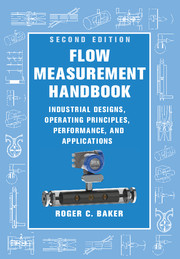Book contents
- Frontmatter
- Dedication
- Contents
- Preface
- Acknowledgements
- Nomenclature
- 1 Introduction
- 2 Fluid Mechanics Essentials
- 3 Specification, Selection and Audit
- 4 Calibration
- 5 Orifice Plate Meters
- 6 Venturi Meter and Standard Nozzles
- 7 Critical Flow Venturi Nozzle
- 8 Other Momentum-Sensing Meters
- 9 Positive Displacement Flowmeters
- 10 Turbine and Related Flowmeters
- 11 Vortex Shedding, Swirl and Fluidic Flowmeters
- 12 Electromagnetic Flowmeters
- 13 Magnetic Resonance Flowmeters
- 14 Ultrasonic Flowmeters
- 15 Acoustic and Sonar Flowmeters
- 16 Mass Flow Measurement Using Multiple Sensors for Single-Phase Flows
- 17 Multiphase Flowmeters 508
- 18 Thermal Flowmeters
- 19 Angular Momentum Devices
- 20 Coriolis Flowmeters
- 21 Probes for Local Velocity Measurement in Liquids and Gases
- 22 Verification and In Situ Methods for Checking Calibration
- 23 Remote Data Access Systems
- 24 Final Considerations
- References
- Main Index
- Flowmeter Index
- Flowmeter Application Index
- Frontmatter
- Dedication
- Contents
- Preface
- Acknowledgements
- Nomenclature
- 1 Introduction
- 2 Fluid Mechanics Essentials
- 3 Specification, Selection and Audit
- 4 Calibration
- 5 Orifice Plate Meters
- 6 Venturi Meter and Standard Nozzles
- 7 Critical Flow Venturi Nozzle
- 8 Other Momentum-Sensing Meters
- 9 Positive Displacement Flowmeters
- 10 Turbine and Related Flowmeters
- 11 Vortex Shedding, Swirl and Fluidic Flowmeters
- 12 Electromagnetic Flowmeters
- 13 Magnetic Resonance Flowmeters
- 14 Ultrasonic Flowmeters
- 15 Acoustic and Sonar Flowmeters
- 16 Mass Flow Measurement Using Multiple Sensors for Single-Phase Flows
- 17 Multiphase Flowmeters 508
- 18 Thermal Flowmeters
- 19 Angular Momentum Devices
- 20 Coriolis Flowmeters
- 21 Probes for Local Velocity Measurement in Liquids and Gases
- 22 Verification and In Situ Methods for Checking Calibration
- 23 Remote Data Access Systems
- 24 Final Considerations
- References
- Main Index
- Flowmeter Index
- Flowmeter Application Index
Summary
Introduction
The object of calibration is to benchmark a flowmeter to an absolute datum. Just as a benchmark tells us how a particular geographical point compares in height with sea level datum, so a calibration of a flowmeter tells us how the signal from the flowmeter compares with the absolute standard of a national laboratory. The analogy is not perfect at this stage. The national laboratory standard must also be compared with other more fundamental measures of time and mass, and it will be essential to check and compare different national standards in different countries from time to time.
There is a desire to reference back to fundamental measurements such as mass, length and time. Thus if we can measure mass flow on a calibration facility by using fundamental measurements of mass and time, this will bring us nearer to the absolute values than, say, obtaining the volume of a calibration vessel by using weighed volumes of water and deducing the volume from the density. The first is more correctly termed primary calibration, whereas the second fails strictly to achieve this. It is likely that the final accuracy will reflect this. Liquid calibration facilities can achieve a rather higher accuracy than is possible for most of the gas calibration facilities. In part, this difference will result from the lower density and the increased difficulties of handling a gas.
The result of a calibration will be both a comparison with the national standard and also a range within which the reading is likely to lie.
Calibration Considerations
Figure 4.1 shows three different approaches to obtaining the data. Although the selection of calibration points and their optimum distribution over the range is not obvious, most of the reference books seem to omit any comment on this. Figure 4.1(a) records data at one flow rate. This might be appropriate if the flowmeter were expected to operate at one rate. It shows the fact that there is variation with time to which the repeatability refers. Such a plot might be used to compare the calibration facility itself with other facilities or to test the consistency of diverter operation. Figure 4.1(b) is probably the most usual plot. Here a number of points have been taken over the full range of the flowmeter.
- Type
- Chapter
- Information
- Flow Measurement HandbookIndustrial Designs, Operating Principles, Performance, and Applications, pp. 67 - 115Publisher: Cambridge University PressPrint publication year: 2016



